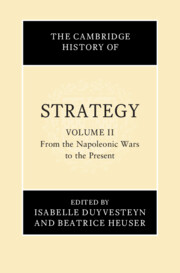Book contents
- The Cambridge History of Strategy
- The Cambridge History of Strategy
- The Cambridge History of Strategy
- Copyright page
- Dedication
- Contents
- Maps
- Contributors to Volume II
- Preface and Acknowledgements
- Introduction to Volume II
- 1 The Strategies of the Napoleonic Wars
- 2 Guerrilla and Nineteenth-Century Strategies of Insurgency
- 3 Russia, 1877–1917
- 4 The American Civil War
- 5 The Use of Naval Power
- 6 The Russo-Japanese War
- 7 Chinese Strategy, 1926–1949
- 8 First World War
- 9 Soviet Strategy, 1917–1945
- 10 Air Power
- 11 The Second World War in Europe
- 12 The Second World War in the Asia–Pacific
- 13 Soviet Strategy, 1945–1989
- 14 People’s War and Wars of Decolonisation
- 15 Nuclear Strategies
- 16 America’s Way of War
- 17 The Korean War
- 18 Israel’s Wars
- 19 The India–Pakistan Confrontations
- 20 The Yugoslav War, 1991–1999
- 21 Terrorism and Insurgency
- 22 The Forty-Year War in Afghanistan
- 23 The Three Gulf Wars and Iraq
- 24 China’s Wars, 1950–2021
- Conclusion
- Further Reading
- Index
6 - The Russo-Japanese War
Published online by Cambridge University Press: 06 January 2025
- The Cambridge History of Strategy
- The Cambridge History of Strategy
- The Cambridge History of Strategy
- Copyright page
- Dedication
- Contents
- Maps
- Contributors to Volume II
- Preface and Acknowledgements
- Introduction to Volume II
- 1 The Strategies of the Napoleonic Wars
- 2 Guerrilla and Nineteenth-Century Strategies of Insurgency
- 3 Russia, 1877–1917
- 4 The American Civil War
- 5 The Use of Naval Power
- 6 The Russo-Japanese War
- 7 Chinese Strategy, 1926–1949
- 8 First World War
- 9 Soviet Strategy, 1917–1945
- 10 Air Power
- 11 The Second World War in Europe
- 12 The Second World War in the Asia–Pacific
- 13 Soviet Strategy, 1945–1989
- 14 People’s War and Wars of Decolonisation
- 15 Nuclear Strategies
- 16 America’s Way of War
- 17 The Korean War
- 18 Israel’s Wars
- 19 The India–Pakistan Confrontations
- 20 The Yugoslav War, 1991–1999
- 21 Terrorism and Insurgency
- 22 The Forty-Year War in Afghanistan
- 23 The Three Gulf Wars and Iraq
- 24 China’s Wars, 1950–2021
- Conclusion
- Further Reading
- Index
Summary
The Russo-Japanese War was fought during 1904–1905 between Tsarist Russia and Imperial Japan. The war broke out due to their conflicting interests in the Korean Peninsula and the north-eastern region of China, known then as Manchuria. Both saw the conflict as a zero-sum game in which compromise was a temporary solution. Japan’s objectives were the control of Korea, the seizure of southern Manchuria and the conclusion of the conflict with a peace agreement that would ensure its own long-term presence and interests in Korea and China. Russia’s objectives were the inverse of Japan’s and included the control of Manchuria, seizure of Korea and the expansion of its political and economic sphere to play a pivotal role in the entire region. Japan had far more limited resources and manpower, but it could mobilise its armed forces more quickly and gain the upper hand in the region, at least initially. As an island country, Japan had to control the seas from the outset and limit the duration of the war. The war lasted seventeen months but demonstrated that when strategic objectives are carefully defined and meticulously executed, as was the case with Japan, then the prima facie weaker party may win.
- Type
- Chapter
- Information
- The Cambridge History of Strategy , pp. 122 - 141Publisher: Cambridge University PressPrint publication year: 2025

